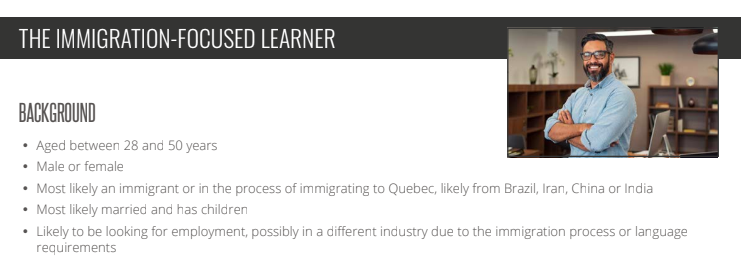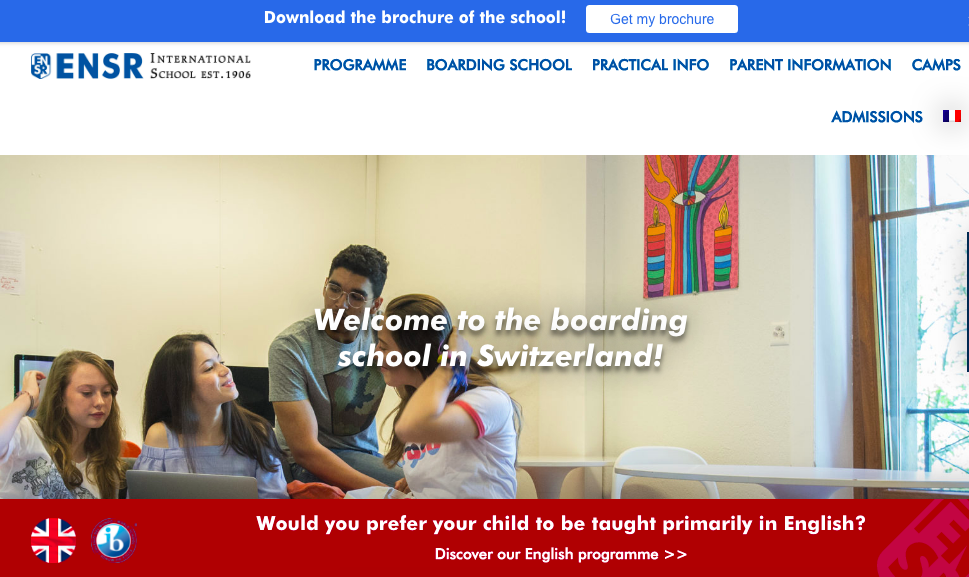Today’s higher education institutions face the mammoth task of differentiating themselves in an increasingly competitive marketplace. It’s a noisy, action-packed space where schools jostle for visibility, forever searching out innovative ways to promote the relevance of their programs and connect with prospective students. When it comes to recruitment, it’s the connecting part that has proven most critical in generating, engaging and converting new leads. Your school can’t hope to successfully attract new students without a clear understanding of their needs, hopes, objectives, and concerns.
Taking the logic a step further, we now seek to understand students’ habits, building behaviorally targeted content that dynamically responds to – even anticipates – the way leads interact with college web platforms. This personalized content is made possible through the creation of student personas, semi-fictional portrayals of your intended audience. Designed to represent the different types of students your school wants to recruit, creating these personas will be essential when it comes to developing engaging websites which provide unique experiences for each user. Below, discover more about website personalization, and how to develop student personas to use in the creation of a website experience that’s tailored to your target audience.

How Website Personalization Supports Your Student Recruitment Strategy
According to a survey conducted by Salesforce, 66% of customers today expect organizations to recognize and cater to their unique needs and desires. This means that a personalized website experience has become increasingly important within any digital marketing strategy. Website personalization refers to the creation of customized user experiences on a website through configuration. These unique experiences, adapted to fit the needs and interests of a particular user, are based on data including user demographics, interests, location, patterns of interaction with the website, and more. As different types of students visit your website, you can segment these prospective leads into distinct personas, based on certain behaviors or characteristics. While the content generated for your website won’t be different for each and every one of your school’s prospective students, through the use of personas, it’s likely to be tailored to a significant portion of them.
The page below is just one of the many examples of what website personalization can look like. Vienna University of Economics and Business’ landing page is appealing to a specific demographic; those seeking a Master’s degree in Business Communication.

Source: Vienna University of Economics and Business
In addition to customized landing pages, website personalization can include a range of strategies, such as unique lead capture forms, alternating homepages, multiple calls to action (CTAs), web forms, and downloadable materials. Your school’s approach to personalization might also take the form of filtering content in order to create individualized recommendations, showcasing the best options for the user in question.
Take ASC English’s webpage below, for example. Here, we can see that there are two alternate homepages featured, one advertising the legacy of the school’s reputation in the Boston area and another catering specifically to international students on a J-1 Visa. These homepages appeal to different audiences – one seeking a school based on reputation and another whose priority is finding a school where they’ll be eligible to train, given their visa status.


Source: ASC English
When it comes to crafting content strategies for schools, a personalization software platform can help you to create a user-friendly experience on your website based on your recruitment goals. Using personalization software, your school’s website and marketing content can be adapted according to the behavioral profiles of your student leads. Examples of popular personalization software include OptinMonster, HubSpot, Segment and Yusp, all of which offer various advantages when it comes to determining user intent and generating targeted content based on analysis.
With personalization, not only will you gain a better understanding of how your website is serving students, but you’ll also boost engagement. Creating a website that’s customized to reflect a student’s previous behavior will encourage them to interact with your web pages longer, increasing the chances of them taking an action, such as subscribing to your mailing list or filling out a form to download a brochure.
Student Persona Building
Now that you understand the concept of website personalization, you can begin to take the next step towards creating a unique experience for your users: developing your student personas. Student personas can be developed based on research about your current and target audiences, compiling data to create realistic representations of your school’s leads. In higher education, website analytics can deliver a wealth of information about visitors. Marketing teams can learn volumes by tracking how leads engage with web pages.
In order to create accurate personas, schools must first know who the majority of their website’s visitors are. Which different groupings do they naturally fall into? As a school, you can use website analytics to obtain valuable data about your website’s audience, including:
- Demographic Factors: Age group, gender, occupation, socioeconomic status
- Location: Where in the world your website’s visitors are located
- Interest categories: What hobbies or passions your visitors have based on prior online purchases, searches or other information you’ve collected
- Device type: What device they’re using to access your website (eg. phone, tablet, laptop, computer)
- Behavior: how prospective students are interacting with your website and the emails they receive (eg. links clicked, amount of time spent on a page, how they got to your page, etc.)
While obtaining accurate visitor data is important in understanding who your website is currently reaching, you can also incorporate other considerations into the personas you build. What types of students would you like to attract to your school? What is the age range, socioeconomic background and ethnicity of the majority of your current students? Does this differ by program or course? Coming up with answers to questions like these can help you to begin accumulating information you can use to develop your target personas, defining the characteristics of different students who are a great fit at your institution.
The examples below demonstrate how data can be arranged into different persona groupings, such as Immigration-Focused Learner, Working Professional and Corporate Team, for instance.



As you may have noted, each of the personas above reflects a different type of student who may be interested in taking courses at a particular school. In order to differentiate between them, demographic factors such as age, gender, socioeconomic status, marital status, employment status and more are taken into account.
Segmenting this data into realistic representations of students helps marketing teams to craft content that truly addresses the motivations, interests and concerns of their most common leads. By further analyzing metrics as pages visited, time spent on each page, links clicked, and searches performed, schools can begin to customize their student recruitment strategy to appeal to the specific types of students they’d like to attract.
Tailoring Website Content to Your Student Personas
Once you’ve identified several key personas for your student leads, you can begin to leverage this knowledge and make changes to how they experience your website and engage with your content. Part of this process involves developing the different types of content you’ll use in the creation of various user experiences. In doing so, you’ll need to come back to the detailed student personas you’ve developed.
Take the Immigration-Focused Learner persona, for example. When the Immigration-Focused Learner returns to the program description page a second time, they should encounter content designed with their profile in mind. Considering what motivations and concerns this persona might have can help to create website content that engages them. See what could be influencing this potential student’s decision below.

Based on these motivations and concerns, website content tailored toward the Immigration-Focused Learner might focus on promoting exam preparation courses, advertising student services for recent immigrants, or displaying career opportunities upon completing a course.
While these are factors that a student learning a language for immigration purposes might have, when the Working Professional visits your page again, the personalized content they encounter will be a little different. Examples of motivations and concerns for this student persona might include:

Upon visiting the school’s website again, the Working Professional might be directed to a landing page highlighting the flexible scheduling options offered by the school, or a blog post focusing on the benefits of business language training.
Case In Point: Using the CTA Button to Create a Personalized Experience
The call to action button (CTA) is one of the simplest yet most effective places to personalize a website. CTAs are quick to grab the attention of the user, directing them to pages where they’ll find more information. With personalization, CTAs have the power to bring a user to exactly the location on your school’s website where they’ll find their motivations and concerns addressed, resulting in a greater likelihood of lead conversion.
Here, École Nouvelle de la Suisse Romande (ENSR) features a CTA that appeals to English-speaking parents, directing them to the section of their website where they’ll find relevant information. When targeting analyzed lead behaviors, the school could design this CTA to change depending on the visitor profile – promoting a financial aid package for students who have searched for funding solutions, or an ebook on re-training strategies for career professionals, for instance.

Source: École Nouvelle de la Suisse Romande
Below, Oxford College uses multiple CTA buttons leading to the web form. This enables the user to obtain information that’s personalized to their interests and needs, enhancing their experience and increasing the chances that they move forward in the conversion process.

Source: Oxford College
In order to attract students with specific backgrounds and interests, Academy of Learning Career College (AOLCC) has designed a website homepage that features a prominent CTA:

Source: Academy of Learning Career College
AOLCC’s homepage is designed to attract a specific persona, appealing to students who are looking to find a program that allows them to make a quick, affordable career transition. From here, they can access the program page with the prospect of finding their new beginning in mind.
Through personalization, your school website evolves into a dynamic, responsive interface, one that’s individualized rather than one-size-fits-all. Not only does this approach improve click-through rates, engagement, and conversion, it provides the much sought-after personalized connection that’s critical to differentiate your school from its many competitors.
As the potential for web analytics increases, it’s becoming easier to see the precise web journey of each prospective student. With this information, marketers are learning exactly what content to serve. When you invest in compiling data about your target audience, you’ll be able to create a website experience that speaks to each and every student. In an age where we rely so heavily on the information we find online, the value of a personalized website for your school’s admissions process cannot be overstated.







